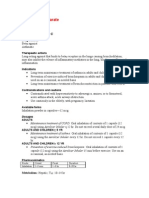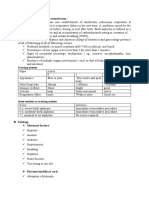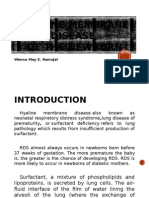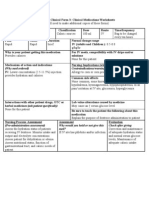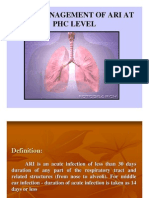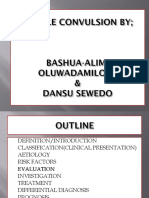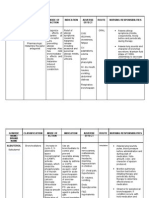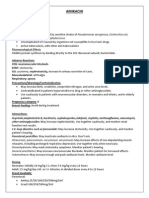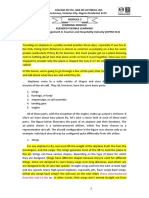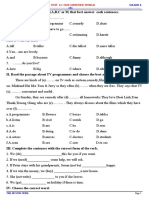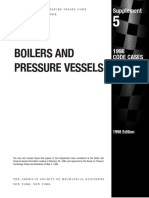Neonatal Resuscitation Drugs
Neonatal Resuscitation Drugs
Uploaded by
blast2111Copyright:
Available Formats
Neonatal Resuscitation Drugs
Neonatal Resuscitation Drugs
Uploaded by
blast2111Original Description:
Original Title
Copyright
Available Formats
Share this document
Did you find this document useful?
Is this content inappropriate?
Copyright:
Available Formats
Neonatal Resuscitation Drugs
Neonatal Resuscitation Drugs
Uploaded by
blast2111Copyright:
Available Formats
Neonatal resuscitation drugs should be stocked in any area in which neonates are resuscitated, including each delivery and
stabilization area, as well as the emergency room. Personnel should be familiar with neonatal medications, concentrations, dosages, and routes of administration. Drugs currently recommended include epinephrine (1:10,000) and isotonic sodium chloride solution (0.9%) as an intra-vascular volume expansion agent.
EPINEPHRINE (ADRENALINE)
Action Sympathomimetic catecholamine Acts directly on alpha and beta receptors Exerts positive ionotropic and chronotropic effect on the heart (Increases strength & rate of cardiac contractions) and relaxes the bronchial smooth muscles Causes peripheral vasoconstriction Increases systemic blood pressure Indication in newborn Treatment of cardiac arrest It is indicated when HR remains < 60 after 30 sec of effective PPV and another 30 sec of coordinated chest compressions and ventilation The only exception to this rule may be in infants who are born without a detectable pulse or heart rate. Severe bradycardia Dosage Intravenous Dose is 0.01 to 0.03 mg/kg per dose (0.1 0.3ml/kg dose of 1:10,000 solution) May repeat every 3-5 min upto 2-3 times Higher intravenous doses are not recommended, and the post-resuscitation hypertension could put premature infants at risk for intraventricular hemorrhage Endotracheal If vascular access cannot be obtained dose should be increased to 3 times that of the intravenous dose (0.03-0.05mg/kg: 1in 10,000 dil) Ensure that the small volume is not deposited on the endotracheal tube connector or in the lumen of the tube. The administration of epinephrine may be followed with 0.5-1 mL of saline to ensure that the drug is delivered to the lung, where it is absorbed and delivered to the heart. Administration of a higher dose (0.05 to 0.1 mg/kg) through the endotracheal tube may be considered, but the safety and efficacy of this practice have not been evaluated (AHA 2010,circulation). Preparation Available concentration 1:1000 Dilute it 10 times to make it 1:10,000 1ml of 1:1000 with 9 ml of water for injection 1:1000 solution means 1ml=1mg (or 0.1ml=0.1mg) 1:10,000 solution means 1ml=0.1mg (or 0.1 ml=0.01mg)
Drug interactions Adrenaline is incompatible with aminophyline, ampicillin, phenobarbitone and sodium bicarbonate. Compatible with normal saline and dextrose solutions Onset of effect Intravenous: immediate If an umbilical venous catheter is used for medication administration, the catheter should be inserted only until blood flow is obtained, usually 3-5 cm. Because the dosing recommendations for epinephrine have included the endotracheal route of administration, the need for emergent placement of umbilical venous catheters has been reduced markedly in the delivery room. Adverse effects Tachycardia Cold extremities Hypertension Necrosis (locally by repeated injections) Decreased renal and splanchnic blood flow Expected response After 30 seconds of administration and continued PPV and CC, HR should increase to > 60 bpm. If no response repeat the dose every 3-5 minutes, repeat doses should preferably be give IV. In case of no response, recheck effectiveness of ventilation and chest compression. Consider Endotracheal intubation, Epinephrine delivery. Also, consider possibility of hypovolemia or severe metabolic acidosis
SODIUM BICARBONATE Action
It may be helpful to correct metabolic acidosis that result from the build up of lactic acid. Severe acidosis causes poor myocardial contraction and blood vessel constriction in the lung, thus decreasing the oxygenation. Sodabicarb releases bicarbonate ions in the body and raises the blood ph. Sodium bicarbonate had previously been recommended in the delivery room to reverse the effects of metabolic acidosis related to hypoxia and asphyxia. However, recent studies show that 0.9% saline provides better cardiac and blood pressure support to correct both the acidosis and the underlying etiology of the metabolic acidosis. Use of sodium bicarbonate in the delivery room has been associated with an increased incidence of intraventricular hemorrhage in very low birthweight infants. Data are insufficient to recommend the routine use of bicarbonate in neonatal resuscitations.
Indication
Sodium bicarbonate, however, may be useful in prolonged arrest after adequate ventilation is established. (when sodium bicarbonate is mixed with acid carbon dioxide is formed.so lungs must be adequately ventilated to remove co2.)
Dosage
A dose of 2 mEq/kg may be intravenously administered. 1-2 ml of 7.5% sodabicarb dilutes with equal amount of distilled water, IV over 3 minutes.( @ <1 mEq/min). Should be given in large vein from which there is good blood return since it is caustic and hypertonic. Never given through ET tube due to the same reason. The subsequent doses are calculated on the basis of arterial pH ideally. But, if they are not available 0.5 mEq/kg can be given every 10 min.
Contra indication
Alkalosis Hypocalcaemia Inadequate ventilation If sodium bicarbonate is used in the face of a persistent respiratory acidosis and elevated pCO2, the acidosis is not corrected. Inj.Soda bicarb 7.5 % solution provides 0.9 mEq/ml of sodium bicarbonate Never in ET route Should be diluted with equal amount of distilled water of double volume of dextrose 5% Bolus administration in preterm babies may result in intra-ventricular haemorrhage
Points to remember
Drug interactions
Incompatible with calcium, cefotaxime, dopamine, dobutamine, magnesium sulphate and atropine
NALOXONE
Administration of naloxone is not recommended as part of initial resuscitative efforts in the delivery room for newborns with respiratory depression. Heart rate and oxygenation should be restored by supporting ventilation (AHA 2010) Mechanism of action Competitive antagonist at opioid receptors. Both endogenous and exogenous opioids are antagonised. Reverses all effects of opioids like respiratory depression, analgesia, papillary constriction, delayed gastric emptying, dysphonia, coma and convulsions. Multiple doses may be necessary due to their short duration of action Onset of effect- IV or ET 1-2 min Dose and route- 0.1 mg /kg /dose as IV bolus/ET/IM /SC, May repeat after 2-3 min, if no response. Available as 0.4 mg/ml Indications Continued Neonatal respiratory depression after positive pressure ventilation has restored a normal heart rate and colour ( due to obstetric analgesia) A history of maternal narcotic administration within past 4 hrs Adverse effects Do not give naloxone to newborn of a mother who is suspected of having addiction to narcotics or is on methadone maintenance. This may result in newborn having seizure
Narcotic withdrawal syndrome may be precipitated in newborn with chronic dependence Abrupt reversal results in vomiting, diaphoresis, tachycardia, hypertension and tremors
VOLUME EXPANDERS
Volume expansion should be considered when blood loss is known or suspected (pale skin, poor perfusion, weak pulse) and the babys heart rate has not responded adequately to other resuscitative measures. In general, the neonatal heart responds well to the increase in preload at the atrial level caused by the volume expansion. Hypovolemia may be masked in a newborn infant because of the significant peripheral vasoconstriction caused by the elevated catecholamines following delivery. Systolic blood pressure also may be elevated falsely with pain. Recommended solutions Isotonic crystalloid Normal Saline Ringer Lactate Colloids 5% albumin, Plasmanate O-negative blood cross-matched with mothers blood (When blood loss is known, restoring the critical oxygen-carrying capacity is essential.) Dose 10ml/kg, Route Umbilical vein/peripheral vein Rate of administration over 5-10 minutes. In premature babies: Rapid boluses may induce ICH
References
www.emedicine.com AAP 2005,Neonatal Resuscitation Manual Drug therapy in paediatrics AHA NRP guidelines 2010
http://www.uihealthcare.com/depts/med/pediatrics/iowaneonatologyhandbook/pulmonary/medicatio ns.html http://pediatrics.aappublications.org/content/126/5/e1400.full
You might also like
- Astronomy - September 2024Document66 pagesAstronomy - September 2024cristosland1984No ratings yet
- Critical Analysis of The Oresund BridgeDocument10 pagesCritical Analysis of The Oresund BridgeVan Cuong PhamNo ratings yet
- Family AssessmentDocument13 pagesFamily Assessmentblast211140% (5)
- Atrovent (Ipratropium)Document1 pageAtrovent (Ipratropium)E100% (2)
- Formoterol FumarateDocument3 pagesFormoterol Fumarateapi-3797941100% (1)
- Newborn Careplan 9-15-2011Document17 pagesNewborn Careplan 9-15-2011Brittany Wood100% (1)
- Brochure Course PCS7 System Course (ST-PCS7SYS)Document4 pagesBrochure Course PCS7 System Course (ST-PCS7SYS)Isaac SanchezNo ratings yet
- Lenovo ThinkPad L440 Wistron LOS 1 DIS UMA 12289 1 Rev 1Document102 pagesLenovo ThinkPad L440 Wistron LOS 1 DIS UMA 12289 1 Rev 1Ramdas KambleNo ratings yet
- Noradrenaline PDFDocument3 pagesNoradrenaline PDFAniend Uchuz ChizNo ratings yet
- Phenobarbitone InjectionDocument13 pagesPhenobarbitone InjectionBrian HarrisNo ratings yet
- MeconiumDocument53 pagesMeconiumAsherrie Bernardo100% (1)
- Drug Presentation On: Aminoven: Submitted To Submitted byDocument6 pagesDrug Presentation On: Aminoven: Submitted To Submitted byShilpi SinghNo ratings yet
- Birth AsphyxiaDocument10 pagesBirth Asphyxiasarita Singh MaharjanNo ratings yet
- NCP Proper 1Document6 pagesNCP Proper 1Noreen PinedaNo ratings yet
- AdrenalineDocument2 pagesAdrenalinerazvan032006100% (1)
- Meconium Aspiration SyndromeDocument29 pagesMeconium Aspiration SyndromeAlwin Varghese T0% (1)
- Congenital Lobar EmphysemaDocument25 pagesCongenital Lobar Emphysemasheme1711No ratings yet
- Acute Bronchiolitis: Zakaria Omar Elzwie Najwa Abdulallah Alfergany (Mub) NovemberDocument28 pagesAcute Bronchiolitis: Zakaria Omar Elzwie Najwa Abdulallah Alfergany (Mub) Novemberزكريا عمر100% (2)
- AcetaminophenDocument1 pageAcetaminophenmaemalabon100% (1)
- Neonatal Respiratory Distress SyndromeDocument12 pagesNeonatal Respiratory Distress SyndromeRazelVillanueva67% (3)
- Drug StudyDocument32 pagesDrug StudyKeepItSecretNo ratings yet
- AminophyllineDocument9 pagesAminophyllineZaira BataloNo ratings yet
- Meconium Aspiration: Ospital NG Maynila Medical Center Department of PediatricsDocument38 pagesMeconium Aspiration: Ospital NG Maynila Medical Center Department of PediatricsGrace Antonette Pati100% (1)
- Hyaline Membrane DiseaseDocument31 pagesHyaline Membrane DiseaseWeng RamojalNo ratings yet
- Drug Study On EPINEPHRINEDocument6 pagesDrug Study On EPINEPHRINEshadow gonzalezNo ratings yet
- DextroseDocument2 pagesDextroseSanket TelangNo ratings yet
- Drug Study On METHERGINEDocument4 pagesDrug Study On METHERGINEshadow gonzalezNo ratings yet
- NitroglycerinDocument5 pagesNitroglycerinapi-3797941100% (1)
- CPDDocument45 pagesCPDVijith.V.kumar100% (1)
- Post-Term Labor - NCPDocument7 pagesPost-Term Labor - NCPCameron De GuzmanNo ratings yet
- Pregnancy Induced HypertensionDocument25 pagesPregnancy Induced HypertensionPauPauNo ratings yet
- Asthalin InhalerDocument7 pagesAsthalin InhalerINDAH WIDYANING TYASNo ratings yet
- Methyldopa, Losartan K, Ascorbic AcidDocument4 pagesMethyldopa, Losartan K, Ascorbic AcidRico Mae ValenciaNo ratings yet
- MethergineDocument3 pagesMethergineJohn AlanoNo ratings yet
- 4 Flow Chart PretermDocument4 pages4 Flow Chart PretermYeni PuspitaNo ratings yet
- Drug Presentation On Morphine SulphateDocument38 pagesDrug Presentation On Morphine SulphateBHUVAN KUMAR. TNo ratings yet
- EPOPROSTENOLDocument6 pagesEPOPROSTENOLMavy CantonNo ratings yet
- DextroseDocument1 pageDextroseAdrianne BazoNo ratings yet
- OxytocinDocument2 pagesOxytocinJoanne Kaye TaylorNo ratings yet
- Drug StudyDocument40 pagesDrug StudyLyka Milo AvilaNo ratings yet
- Meconium-Stained Amniotic Fluid MSAFDocument54 pagesMeconium-Stained Amniotic Fluid MSAFJhansi PeddiNo ratings yet
- Chlorthalidone HygrotonDocument2 pagesChlorthalidone HygrotonLIEZEL GRACE VELAYONo ratings yet
- Levonorgestrel: Mechanism of ActionDocument6 pagesLevonorgestrel: Mechanism of ActionAdditi SatyalNo ratings yet
- Chlorpheniramine Maleate: (klor-fen-AIR-uh-meen MAL-ee-ate)Document4 pagesChlorpheniramine Maleate: (klor-fen-AIR-uh-meen MAL-ee-ate)Nurginayah RusliNo ratings yet
- NifedipineDocument2 pagesNifedipineapi-3797941100% (3)
- Respiratory Distress SyndromeDocument30 pagesRespiratory Distress SyndromeDennis MiritiNo ratings yet
- Nicu Drug StudyDocument8 pagesNicu Drug StudyMike SoySauce LibrojoNo ratings yet
- Arterial PunctureDocument14 pagesArterial PunctureGstayu WidiastutiNo ratings yet
- Case Management of Ari at PHC LevelDocument29 pagesCase Management of Ari at PHC Levelapi-3823785No ratings yet
- CarbamazepineDocument5 pagesCarbamazepineapi-3797941100% (3)
- CiprofloxacinDocument3 pagesCiprofloxacinapi-3797941No ratings yet
- Drug Name Mechanism of Action Indications Contraindications Adverse Effect Nursing ConsiderationsDocument2 pagesDrug Name Mechanism of Action Indications Contraindications Adverse Effect Nursing ConsiderationsKatrina PonceNo ratings yet
- LamivudineDocument2 pagesLamivudineRosher Deliman JanoyanNo ratings yet
- Nursing Care Plan For Interrupted Breastfeeding NCPDocument3 pagesNursing Care Plan For Interrupted Breastfeeding NCPSaira SucgangNo ratings yet
- Febrile ConvulsionDocument20 pagesFebrile ConvulsionnoblefxNo ratings yet
- Lrti Case Drug StudyDocument6 pagesLrti Case Drug Studyn_I_K_K_I02No ratings yet
- RifampinDocument3 pagesRifampinZenit DjajaNo ratings yet
- AmikacinDocument1 pageAmikacinMuhammad Arsalan100% (1)
- Newborn Physical ExaminationDocument17 pagesNewborn Physical ExaminationMaria Isabel de LeonNo ratings yet
- Newborn AssessmentDocument9 pagesNewborn Assessmentapi-237668254No ratings yet
- Role of Dietary Fibers and Nutraceuticals in Preventing DiseasesFrom EverandRole of Dietary Fibers and Nutraceuticals in Preventing DiseasesRating: 5 out of 5 stars5/5 (1)
- Ventricular Septal Defect, A Simple Guide To The Condition, Treatment And Related ConditionsFrom EverandVentricular Septal Defect, A Simple Guide To The Condition, Treatment And Related ConditionsNo ratings yet
- Drug StudyDocument7 pagesDrug StudydivineNo ratings yet
- Drugs (Eng) Dr. Rina Atau Dr. AdhiDocument27 pagesDrugs (Eng) Dr. Rina Atau Dr. AdhiadelNo ratings yet
- Neonatal ShockDocument50 pagesNeonatal ShockBenazir Nabilla RojwaaNo ratings yet
- Rotation PlanDocument1 pageRotation Planblast2111No ratings yet
- Drugs Used in Liver DiseaseDocument17 pagesDrugs Used in Liver Diseaseblast2111No ratings yet
- Tracheo Esophageal FistulaDocument6 pagesTracheo Esophageal Fistulablast2111No ratings yet
- Group DynamicsDocument12 pagesGroup Dynamicsblast2111100% (1)
- Essential Newborn CareDocument8 pagesEssential Newborn Careblast2111No ratings yet
- Programmed InstructionDocument7 pagesProgrammed Instructionblast2111No ratings yet
- Commented Research Proposal @GTSDocument13 pagesCommented Research Proposal @GTSMahedere TebebeNo ratings yet
- RIDADocument108 pagesRIDAmyrank.techpptNo ratings yet
- Sprinkler Test 3Document5 pagesSprinkler Test 3nag_2004No ratings yet
- Stanislavski ExercisesDocument8 pagesStanislavski ExercisesdonnaroseokeeneyNo ratings yet
- Eco Friendly Textiles - PART-1Document85 pagesEco Friendly Textiles - PART-1Sangeethapriya AvinutyNo ratings yet
- Pico de Loro Beach and Country Club Guide MapDocument1 pagePico de Loro Beach and Country Club Guide MapArjay MelanoNo ratings yet
- Satellite c800Document246 pagesSatellite c800Tong BbmNo ratings yet
- Wind Power in Argentina Policy Instruments andDocument6 pagesWind Power in Argentina Policy Instruments andbiblioteca economicaNo ratings yet
- CIRED TB 749 - Earthing - 416390355 2 Pages Per Sheet-B-35-35-ReportDocument99 pagesCIRED TB 749 - Earthing - 416390355 2 Pages Per Sheet-B-35-35-Reportzoran.bozic1398No ratings yet
- Lms Chem 1Document15 pagesLms Chem 1Ahmed HusamNo ratings yet
- G48 Datasheet G481109B PDFDocument2 pagesG48 Datasheet G481109B PDFFabianNo ratings yet
- Formula Sheet: Section 1 - Deterministic Dynamic ProgrammingDocument10 pagesFormula Sheet: Section 1 - Deterministic Dynamic Programmingסהר זילברמןNo ratings yet
- What Is NSX-T ArchitectureDocument12 pagesWhat Is NSX-T Architecturemohamed100% (1)
- Parts of An AirplaneDocument12 pagesParts of An AirplaneMaritoni MedallaNo ratings yet
- Book 1518450482Document14 pagesBook 1518450482rajer13No ratings yet
- Unit 11.2doc.Document4 pagesUnit 11.2doc.Davis HoàngNo ratings yet
- User Manual: 1080p WebcamDocument1 pageUser Manual: 1080p WebcamkarlkarlsonNo ratings yet
- Control System FinalDocument200 pagesControl System FinalqwertyNo ratings yet
- School Disaster Risk Reduction and Management and Cca Action Plans TemplateDocument2 pagesSchool Disaster Risk Reduction and Management and Cca Action Plans TemplateJessavel De VeneciaNo ratings yet
- BPVC Code Cases 5 PDFDocument54 pagesBPVC Code Cases 5 PDFEymenNo ratings yet
- Karim Jan Risk Assessment ProjectDocument2 pagesKarim Jan Risk Assessment Projectkarimjan614No ratings yet
- World-Wide Technical Reference Guide: Upright RegulationDocument25 pagesWorld-Wide Technical Reference Guide: Upright Regulationcjarcher1677No ratings yet
- ABB InstrumentationDocument32 pagesABB InstrumentationMarouan BelhouchetteNo ratings yet
- High Efficiency, High Power Density Electric MotorsDocument12 pagesHigh Efficiency, High Power Density Electric MotorsDileep SettyNo ratings yet
- 30072-454-87 RelayDocument24 pages30072-454-87 RelayJose GonzalezNo ratings yet
- Precis Writing ExercisesDocument10 pagesPrecis Writing ExercisesChinnari ChinnuNo ratings yet




